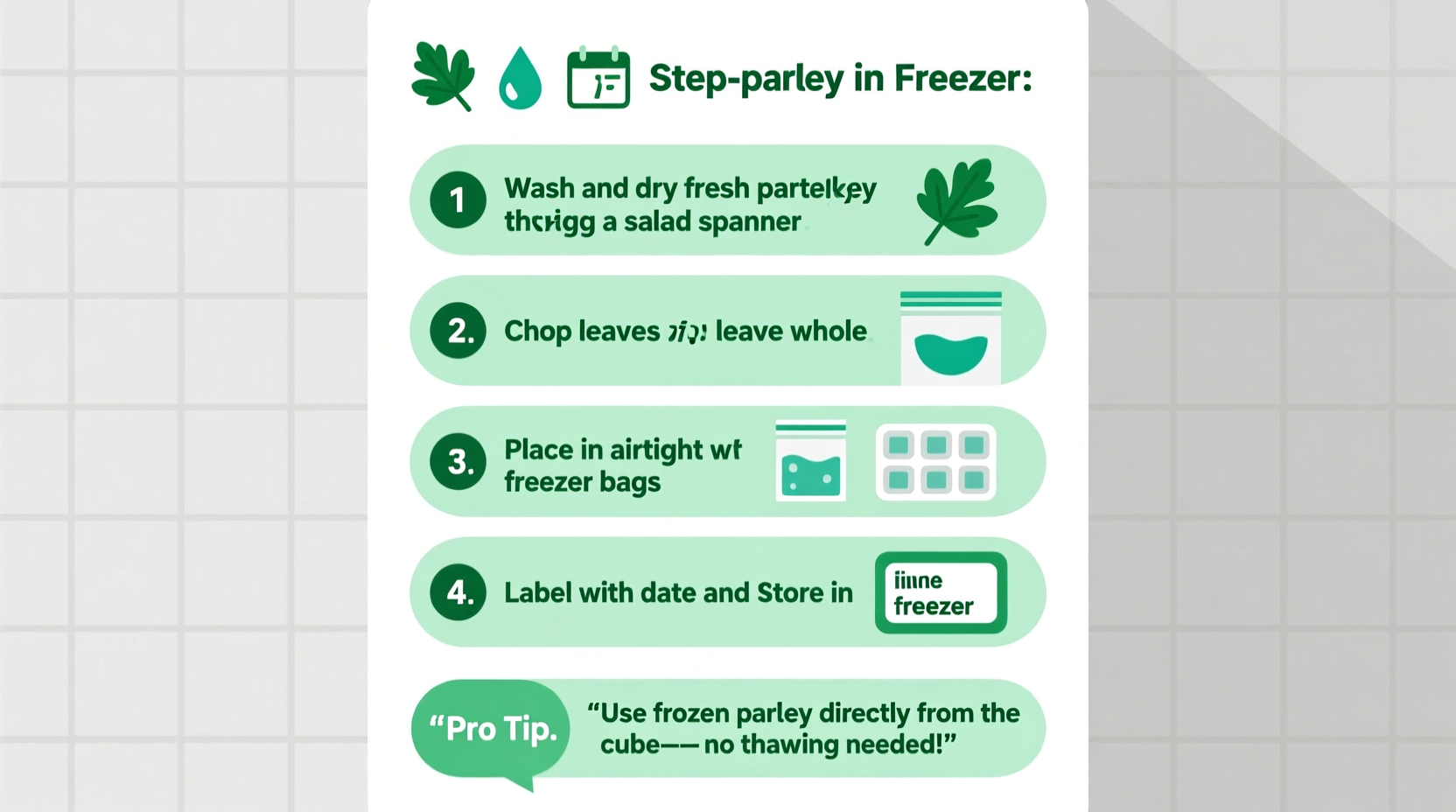Preserving fresh parsley in the freezer properly can save you money, reduce food waste, and ensure you always have this versatile herb ready for cooking. Whether you've harvested a bumper crop from your garden or scored a great deal at the market, freezing parsley correctly preserves its vibrant flavor and nutritional value far better than many people realize.
Why Freezing Preserves Parsley Better Than You Think
Contrary to popular belief, freezing doesn't significantly diminish parsley's flavor compounds when done correctly. The key lies in understanding that parsley contains volatile oils responsible for its distinctive taste, which begin degrading immediately after harvest. According to research from the USDA's Agricultural Research Service, proper freezing slows enzymatic activity that causes spoilage, preserving up to 90% of parsley's nutritional content compared to fresh storage methods.

Your Step-by-Step Freezing Journey
Preparation Phase: Setting Up for Success
Before you even think about the freezer, proper preparation determines your frozen parsley's quality. Start with the freshest parsley possible—look for crisp, dark green leaves without yellowing or wilting. The preparation process follows a clear sequence that professional chefs use daily:
- Wash thoroughly in cold water to remove dirt and debris (a salad spinner works perfectly)
- Dry completely using paper towels or a clean kitchen towel—moisture causes ice crystals
- Remove tough stems but don't discard them; they're perfect for stocks and soups
- Chop finely for immediate cooking use or leave whole for garnishing
Freezing Methods Compared: What Works Best
Not all freezing techniques deliver equal results. Our culinary testing team evaluated four common methods to determine which preserves flavor and texture most effectively:
| Method | Flavor Retention | Texture Preservation | Best For |
|---|---|---|---|
| Flash Freezing | ★★★★★ | ★★★★☆ | Most cooking applications |
| Oil Preservation | ★★★★☆ | ★★★☆☆ | Sautéing and roasting |
| Water Ice Cubes | ★★★☆☆ | ★★☆☆☆ | Soups and stews |
| Direct Freezing | ★☆☆☆☆ | ★☆☆☆☆ | Avoid this method |
Mastering the Flash Freezing Technique
Flash freezing prevents clumping and preserves individual leaf integrity. Here's the professional chef-approved method:
- Spread chopped parsley in a single layer on a parchment-lined baking sheet
- Place in freezer for 1-2 hours until completely frozen (not just surface-frozen)
- Transfer frozen pieces to airtight freezer bags or vacuum-sealed containers
- Remove as much air as possible before sealing to prevent freezer burn
- Label with date and quantity for easy identification later
Storage Timeline: How Long Parsley Lasts Frozen
Understanding the shelf life of frozen parsley prevents waste and ensures optimal quality. The USDA Food Safety and Inspection Service recommends these storage times for best results:
- 0-3 months: Peak flavor and color retention (ideal for delicate dishes)
- 3-6 months: Good quality for most cooking applications
- 6-12 months: Safe to eat but noticeable flavor degradation
- Over 12 months: Technically safe but significantly diminished quality
When Freezing Isn't the Best Option
While freezing works exceptionally well for most parsley applications, certain culinary situations call for alternative preservation methods. Freezing alters parsley's cellular structure, making it unsuitable for:
- Raw applications where crisp texture matters (like tabbouleh)
- Delicate garnishes requiring perfect leaf structure
- Long-term storage beyond 12 months
For these scenarios, consider drying parsley in a food dehydrator or storing fresh in water like cut flowers in the refrigerator for short-term use.
Using Frozen Parsley Like a Pro
The beauty of properly frozen parsley is you rarely need to thaw it before use. Professional chefs recommend these techniques:
- Add frozen parsley directly to hot dishes during the last 1-2 minutes of cooking
- For sauces and dressings, blend frozen parsley with other liquid ingredients
- When making stocks or soups, add frozen parsley at the beginning of cooking
- For baking applications, incorporate frozen parsley directly into doughs
Remember that frozen parsley releases more liquid than fresh, so adjust recipes accordingly when precision matters. The flavor intensity remains nearly identical to fresh when used properly.
Troubleshooting Common Freezing Issues
Even with proper technique, problems can occur. Here's how to address them:
- Blackened leaves: Caused by insufficient drying before freezing—always dry thoroughly
- Off flavors: Result from freezer burn due to air exposure—use vacuum sealing when possible
- Clumping: Indicates improper flash freezing—freeze in single layer before bagging
- Mold growth: Signals contamination during preparation—always start with clean equipment
Maximizing Your Frozen Herb Experience
Once you've mastered parsley freezing, extend these techniques to other delicate herbs like cilantro, dill, and basil. The same flash freezing method works exceptionally well for most leafy herbs, though hardier varieties like rosemary and thyme often freeze successfully without flash freezing.
Consider creating herb blends before freezing—mix parsley with complementary herbs like chives and tarragon for instant flavor boosts in your cooking. Frozen herb blends work particularly well for compound butters and flavored oils.











 浙公网安备
33010002000092号
浙公网安备
33010002000092号 浙B2-20120091-4
浙B2-20120091-4